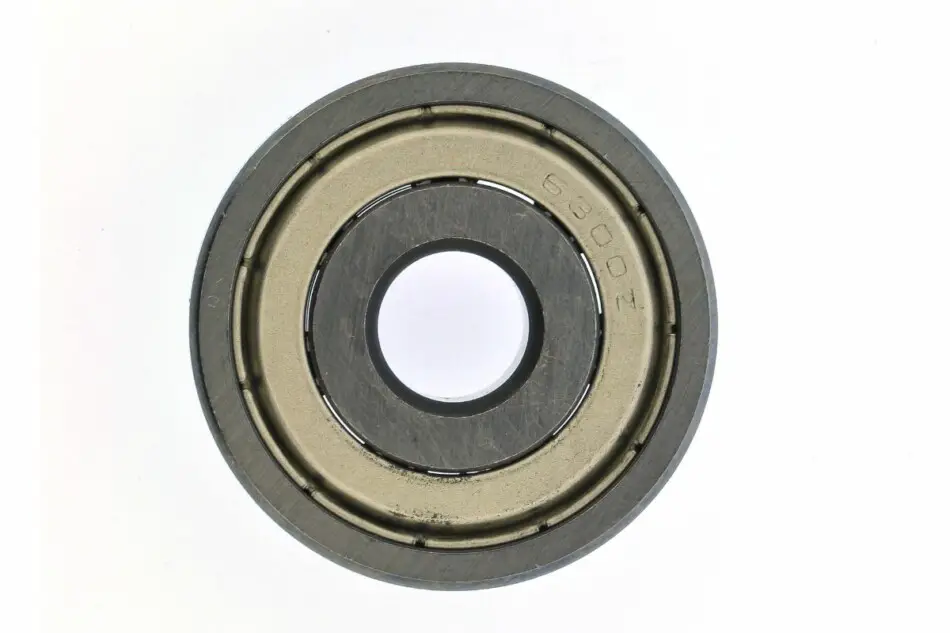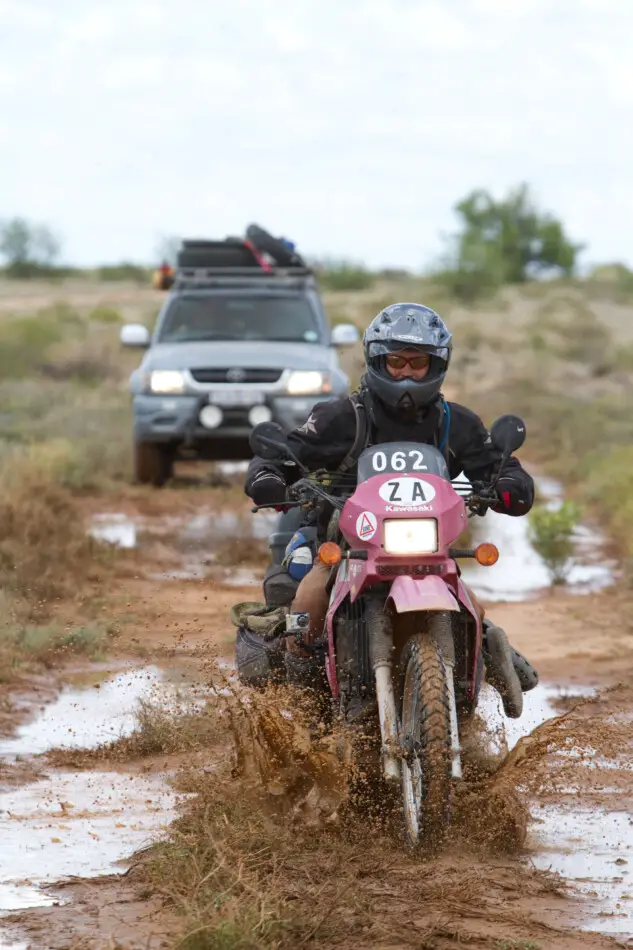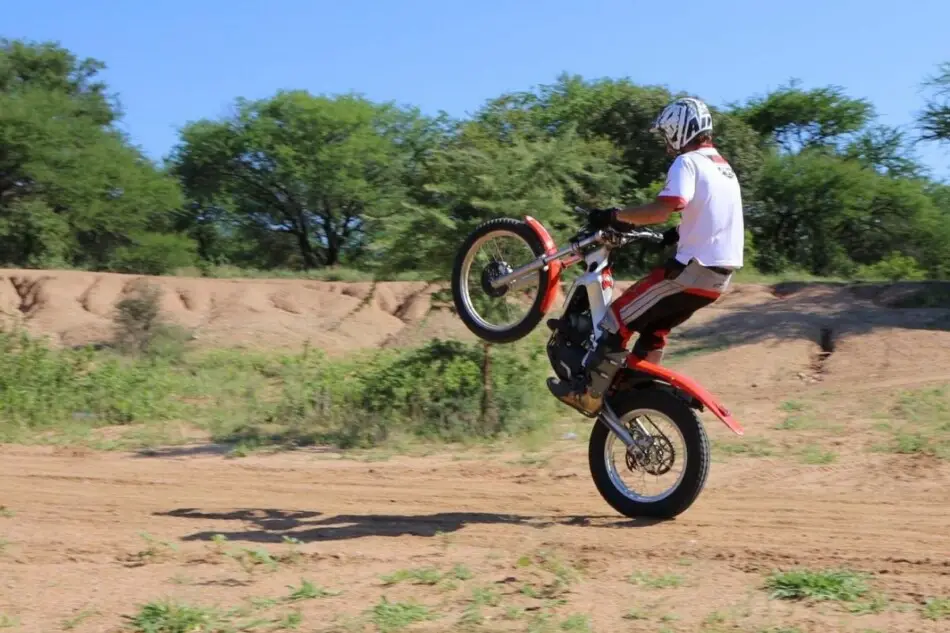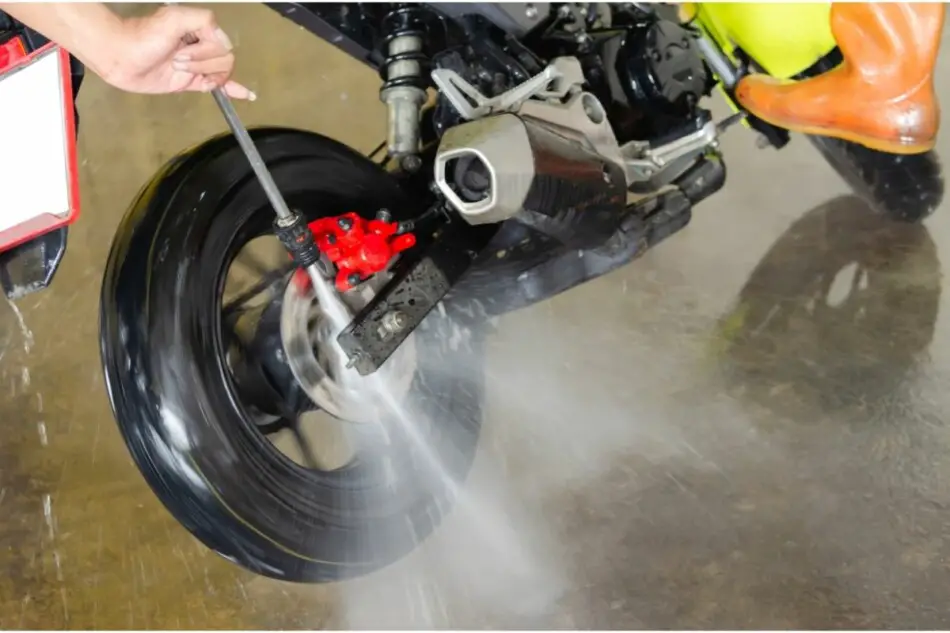Wheel bearings on your motorcycle can last forever if you don’t mistreat them, but if your wheel bearings fail the results could be disastrous. That’s why it is a good idea to inspect your wheel bearings once in a while.
A motorcycle wheel bearing is bad when it makes a grinding noise and there’s lateral play at the wheel hub. Bad front bearings may cause vibration in the handlebars and bad rear bearings may cause the rear wheel to fishtail. If a bearing makes a noise, binds or is loose when you rotate it with your finger in the axle hole, the bearing is bad.
While your wheel bearings will likely never give you issues, it is important to understand how they work and what to look out for. Because if they fail, and they sometimes do, it could result in a serious crash.
How to Wheel Bearings Work?
Wheel bearings are the link between your spinning wheel and the stationary axle. Without the bearing, the friction would be too much and the wheel would not spin, or heat up and cease. The bearing is pressed into the wheel, so it is a tight fit. There is also no play between the axle and the inner race of the bearing.
Inside the bearing, there are a bunch of shiny balls or rollers that run in races between the inner and outer part of the bearing. These balls need to be clean and lubricated with bearing grease in order to do their job and to last. They need to spin the wheel hundreds of times per mile.
Modern motorcycles all have sealed wheel bearings that are pre-greased. These bearings require zero maintenance and are the reason why you probably never have to worry about wheel bearings going bad.

Most older motorcycles had serviceable wheel bearings. You had to periodically inspect the bearing for play, wear or discoloring (which indicates overheating). You also had to clean the bearings in kerosene and repack them with grease.
If your wheel bearings are clean and spin freely without lateral play, they will make your wheel spin safely for a very long time.
How to Check Whether a Wheel Bearing is Bad
A failing wheel bearing usually only lets you know it’s on its way out when it has already worn quite a bit. It pays, therefore, to check your wheel bearings every time you service your motorcycle. Also check them after a dirty ride through water, mud or sand.

If you like to wheelie or jump your bike, or if one (or both) of your wheels had a hard knock (like a curb or a sidewalk), check your wheel bearings for damage.
Here’s how you can identify a wheel bearing that’s going bad:
Humming sound while riding
While riding, listen for a humming sound from your wheel. If you wheel bearing is not worn too badly, it may be impossible to hear a difference. A badly worn bearing will emit a humming noise from the vibration of the loose or binding bearing.
If you do hear a strange sound from the wheel, pull in the clutch to eliminate transmission and engine noises. Also try this on different road surfaces to make sure it is not the tires on the specific substrate you are riding on.
Make sure your tires are properly inflated. A deflated tire can also cause a humming sound while riding.
Vibrations through the handlebars
Vibrating handlebars could be a sign of failing wheel bearings. If there is too much play in the bearings. the front wheel won’t run true and this could increase the risk of a tank slapper too.
Vibrations in the handlebar could have other causes too, including a deflated or damaged tire, unbalanced wheel, or loose spokes. Have it checked out before you develop the death shake.
Wandering steering
Play in the front wheel bearings will prevent your front wheel from rotating 100% straight. The slight side-to-side movement at the axle and hub will cause the front end to wander. You might not notice this riding normally, but if you let go of the handlebars the bike might swerve to one side (be careful if you let go with both hands – you’ve been warned! – plus it is illegal).
A worn steering head bearing will also cause wandering steering, so make sure to inspect it too while you’re at it.
Rear wheel feels flat
If it feels like your rear wheel is flat and fishtailing, but the tire is hard and your axle nut is tight, it may we your rear wheel bearings that are failing. The excess play in the bearings will cause your wheel to wobble slightly which may make it feel like your back-end is not following the front.
Brake disc is hot
If you hear a suspicious sound while riding, feel your brake rotors (discs). If they are scalding hot, it may be your wheel bearings that are dry. The friction from metal spinning on metal will generate a lot of heat.
Hot discs may also be as a result of a binding brake pad, so check that the pads move away (slightly) from the discs when you let go of the lever. If they do, take a closer look at your bearings.
Check the bearings with the wheel off the ground
Secure the motorcycle and lift the wheel off the ground. Spin the wheel with your hand and listen for any grinding noises. The wheel should spin freely without and grabbing. If there is a spot where the wheel binds, check that it is not your brake pads touching the brake disc. If the brakes are fine, it could be your wheel bearings.
To inspect your wheel bearings for excessive play, with the wheel off the ground, grab the wheel at the top and bottom (or 12 & 6 o’clock) and rock the wheel from side-to-side. There should not be any lateral movement.
Take a closer look at your bearings
If any of the tests above make you suspect a bearing is busy going bad, it is best to take a closer look to know for sure.
To do this, remove the wheel and axle, and stick your finger into the wheel bearing. Rotate the bearing with your finger. It should feel smooth all the way around without any binding. If the bearing feels loose or if there are spots that grind or snag, the bearing needs to be replaced.
Visually inspect the bearing for any discoloration. Wipe the bearing off with a rag and check that the outer and inner race looks like clean metal. If there are darker spots, it is a sign that the bearing got too hot due to friction. Replace the bearing.
If you have sealed bearings (like most modern motorcycles), the bearings should be dry on the outside. If there is any grease leaking out at the seals, the bearings need replacement. If you have old, unsealed bearings, you will have to remove, clean and repack them with grease periodically.
What Causes Wheel Bearings to Go Bad?
Generally, modern sealed wheel bearings will last a very long time and need very little maintenance (except if you have a classic bike with serviceable bearings). There are, however, a few things that may cause your bearings to fail prematurely.
Riding in the dirt
Wheel bearings need to stay perfectly clean inside. That’s why the modern ones are sealed. If you never ride on gravel or dirt roads, and don’t really ride in the rain, there is no reason why your bearings should get dirt inside them. The only thing that could happen is a seal that fails. That’s why it is important to inspect your bearings once in a while.

An incorrectly installed bearing that was damaged or one of poor quality may also start leaking grease out and letting dirt get in.
If you ride in the dirt, mud, or sand often, it is important to periodically check the condition of your wheel bearings. After washing your bike (you wash your bike, right?), wipe the bearing dry and check that it looks in good condition.
Dirt bike riders may have to replace wheel bearings more often than road riders.
Bumps, jumps and wheelies
Bearings are designed to roll instead of absorb impacts. If you frequently wheelie your motorcycle, the hard landing may result in premature failure of your front wheel bearings. Keep an eye on them.

Similarly, if you take large jumps, the impact of the landings may wear out your wheel bearings faster. Again, it’s the dirt bikers that may have to replace bearings more often.
Even if you don’t wheelie or jump your bike, be aware that a hard knock on one of the wheels could also damage the wheel bearings enough to initiate premature wear. If you hit a pothole or a curb quite hard, remember to inspect your wheel bearings the next time you adjust your chain or wash your bike.
Even better, check it after that same ride.
The knock could result in slight damage that may not be noticeable right away. If you don’t inspect the bearings immediately, you’ll likely forget about the impact and may only notice the problem when the bearing suddenly explodes a few months later (hopefully not at 75 mph!).
Pressure washing
Washing your motorcycle regularly is a very good idea. It will prevent rust and fading of the paintwork, and it is the perfect chance to inspect critical parts of your bike. If you want to learn which components are the most critical for your safety, check out my e-Guide here.
Gently wash your hubs and wipe the wheel bearings clean with a rag. Check that there are no grease leaks and that the bearings and seals are not damaged. DO NOT pressure wash your hubs and bearings, as this could force water into the bearings past the dust seals which will dilute the grease, cause the bearings to rust, and very quickly deteriorate.

How to Make Wheel Bearings Last Longer
This section is basically the reverse of the previous section, so I’ll keep it short.
Keep your bearings clean. If you ride in the dirt or through mud and water often, you’ll have to inspect the bearings more frequently. When you wash your bike, don’t pressure wash the wheels (or any areas where there are bearings – e.g. steering head, swing arm pivot, shock mount).
If you often jump or wheelie your motorcycle, or ride motocross or enduro, your bearings are not going to last as lost of someone who commutes or tours on the tarmac. You’ll have to keep an eye on your bearings if the wheels take a lot of hits.
And if you don’t jump or wheelie, but you hit a pothole or a curb quite hard, take the time to inspect the wheel bearings to ensure that they didn’t get damaged.
Regardless of where you ride or how, it is good practice to regularly inspect the critical components that keep your bike safe.
Conclusion
Wheel bearings don’t just go bad. They deteriorate over time and usually only if they are neglected. Unfortunately, wheel bearings don’t complain all that loudly, so you need to be sensitive to their needs. Keep your ears open and be aware of extra vibrations. Better yet, inspect them regularly.
It takes 5 minutes to properly inspect your wheel bearings and early detection can save you from a serious accident.
Ride safe!

